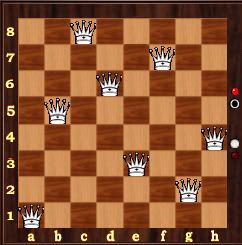Intel Xeon processor servers servers
In honor of the return of T! games, I leave this information, not very useful at this time, but I hope you like it.
The problem of the eight women
This is a famous question, basically, is stated as: "On a 8x8 chessboard place eight ladies so they do not threaten each other."
The interest aroused was remarkable, and celebrated mathematicians have devoted much research. Currently this problem is quite determined and even there is a generalization of it. ("In a nXn chessboard squares, place n ladies so as not to threaten each other." This generalization is determined by the Belgian mathematician and chess Kraitchik.)
About this problem, the mathematician says: "The problem of the eight women is a math problem for chess and chess problem for the mathematician."
From a historical standpoint, the problem was proposed by Dr. Nauck the illustrious mathematician Gauss in 1850 (although paternity can be attributed to Max Bezzel, who published in 1848 in Schachzeitung). Gauss first found 72 solutions, and, somewhat later, 76 and finally, Dr. Nauck (whose merit is increased by being blind) found the 92 possible solutions, today recognized as the definitive number.
To address the problem from a mathematical point of view is that state it another way: "Calculate the number of possible permutations of the first 8 natural numbers with two restrictions: a) two consecutive numbers are not in the order normal arithmetic b) two neighboring figures never are in the normal arithmetic order. "
They are the following:
1 permutation, ie, 1x4 = 4 permutations that begin with 1 (1TD).
2 permutations, ie 2x4 = 8 permutations that begin with 2 (2TD).
4 permutations, ie, 4x4 = 16 permutations that begin with 3 (3TD).
9 permutations, ie 9x4 = 36 permutations that begin with 4 and 5 (4TD and 5TD).
4 permutations, ie, 4x4 = 16 permutations that begin with 6 (6TD).
2 permutations, ie 2x4 = 8 permutations that start with 7 (7TD).
1 permutation, ie, 1x4 = 4 permutations that start with 8 (8TD).
The solutions start with 1 and 8 are less numerous because if a woman occupies a square corner, the long diagonal is already prohibited. By contrast, solutions that start with 4 and 5 are the most numerous. That is, if we get a solution by trial and error, we put the first lady or 4TD 5TD.
It shows that, from a solution, you can get other seven (reverse, complementary, complementary inverse, reciprocal, reciprocal inverse, and inverse autorrecÃproca autorrecÃproca), so it is possible to find fewer solutions and then find the others.
• For the mathematical reader and start to lose patience, calm him and then writing a table with the set of all solutions are briefly removing the name of the column and keeping only the number of the row. For example, the solution means 6824 1753 a6, b8, c2, d4, e1, f7, g5, h3 in algebraic notation and 6TD, 8CD, 2AD, 4D, IR, 7AR, 5CR, 3TR in the specification.

Here is the first of the solutions.

Salu2.
No hay comentarios:
Publicar un comentario